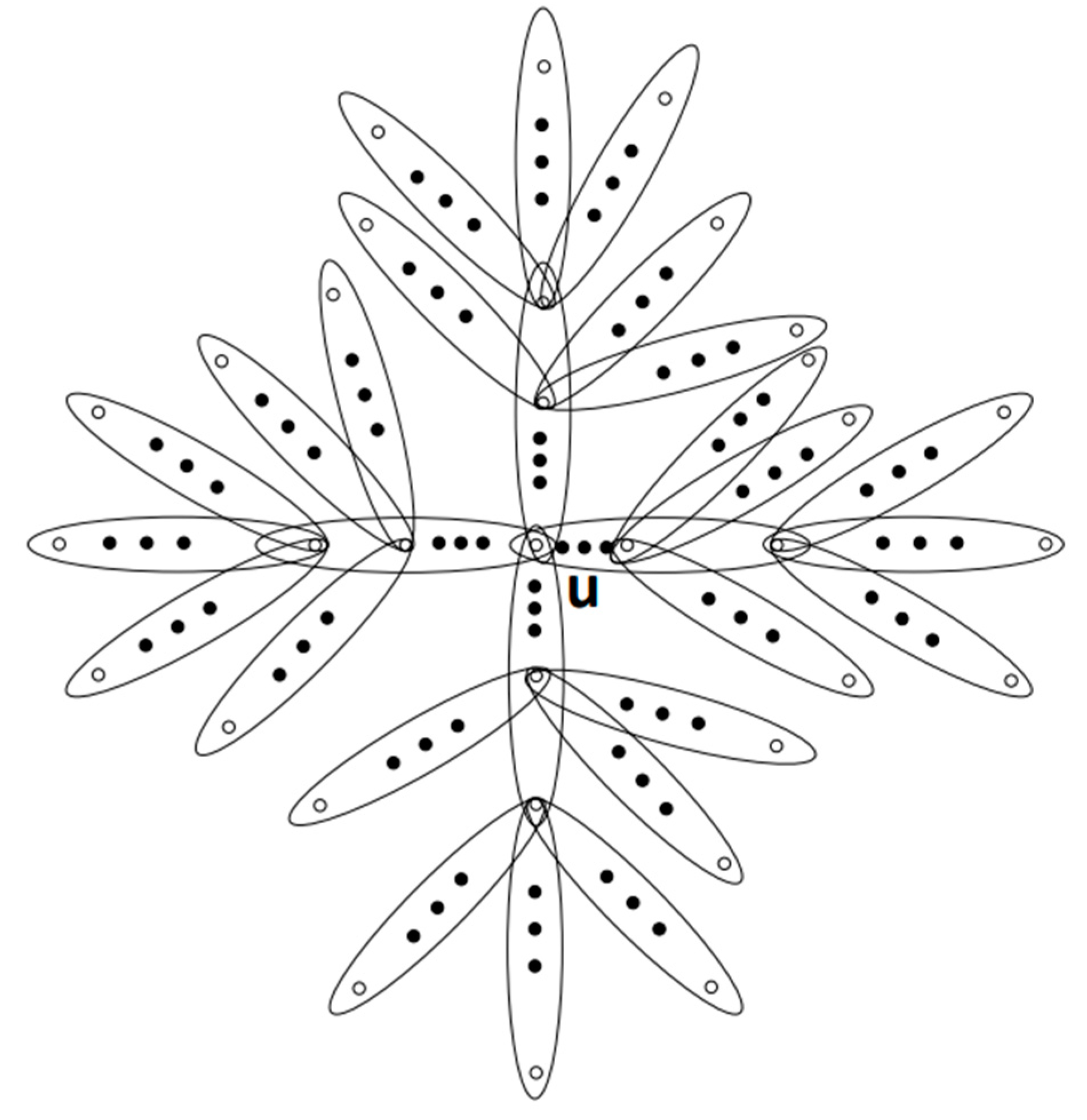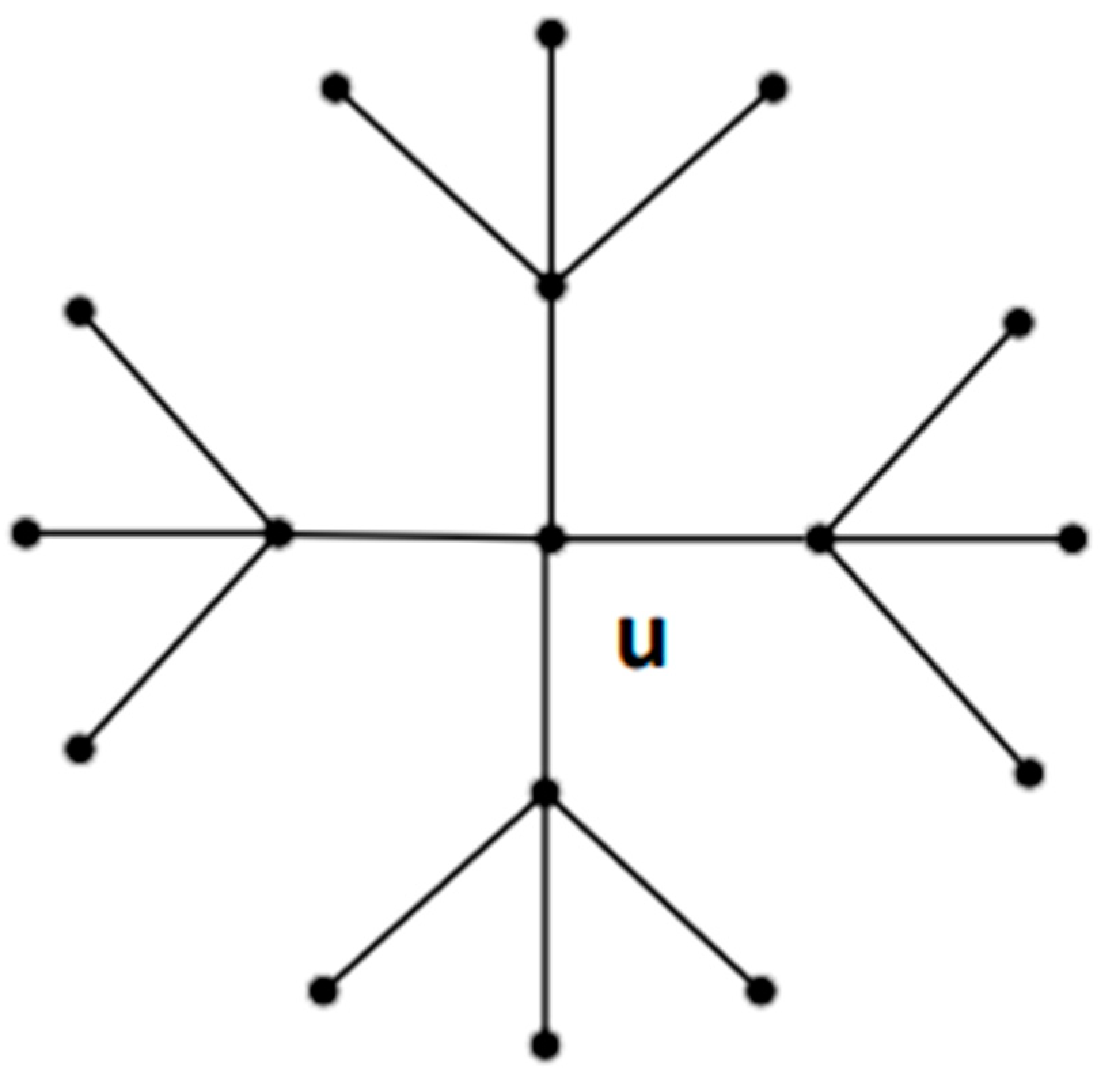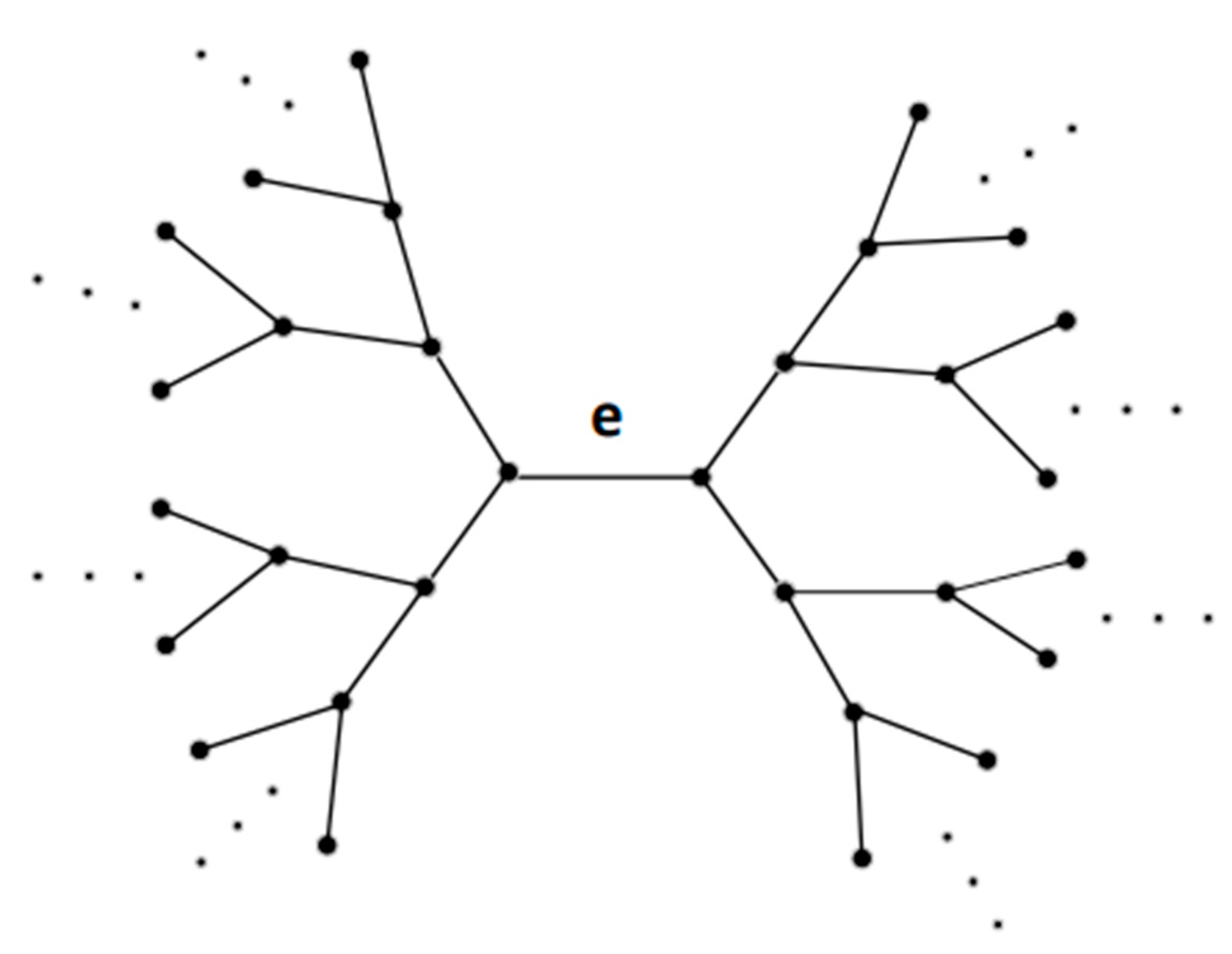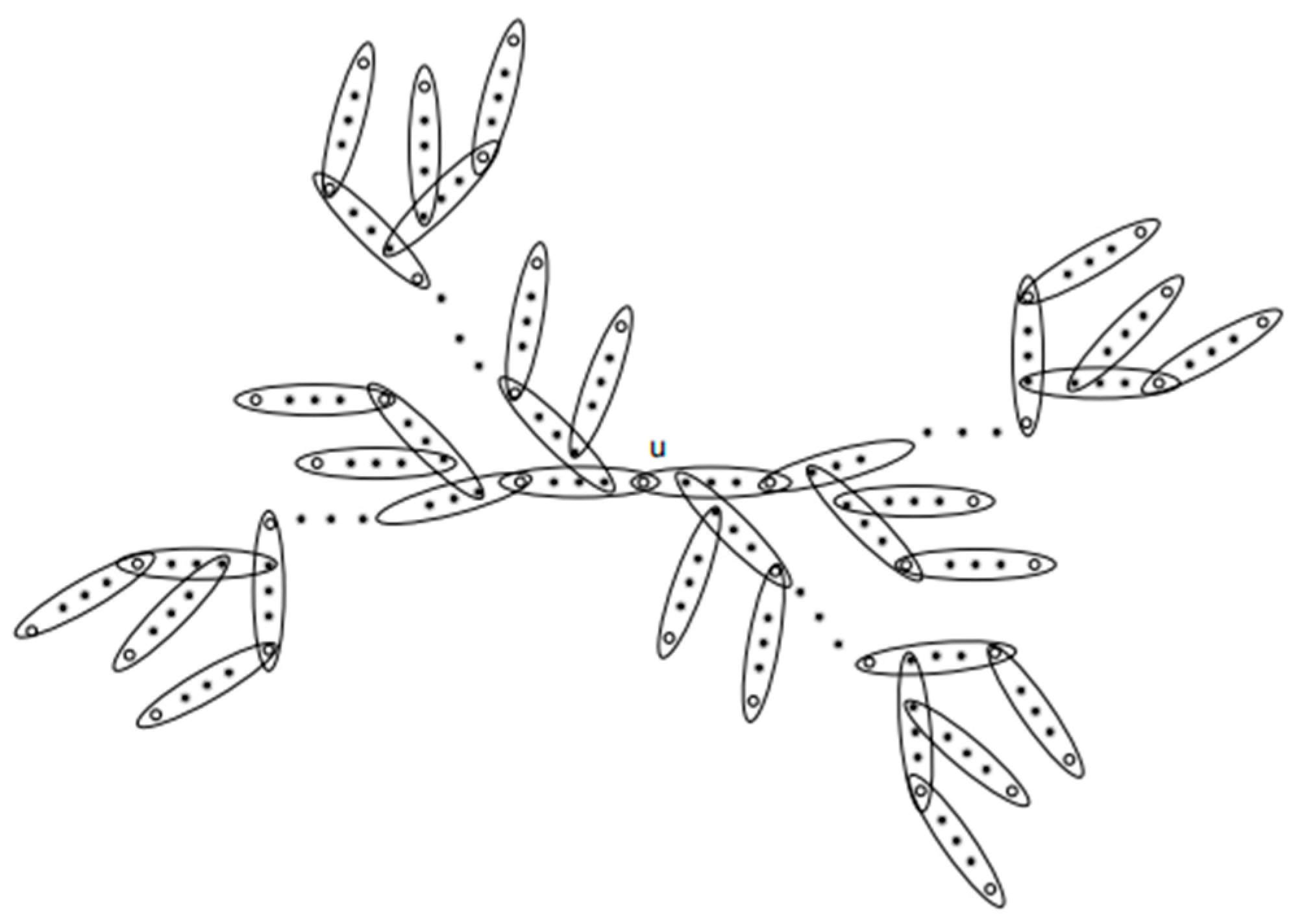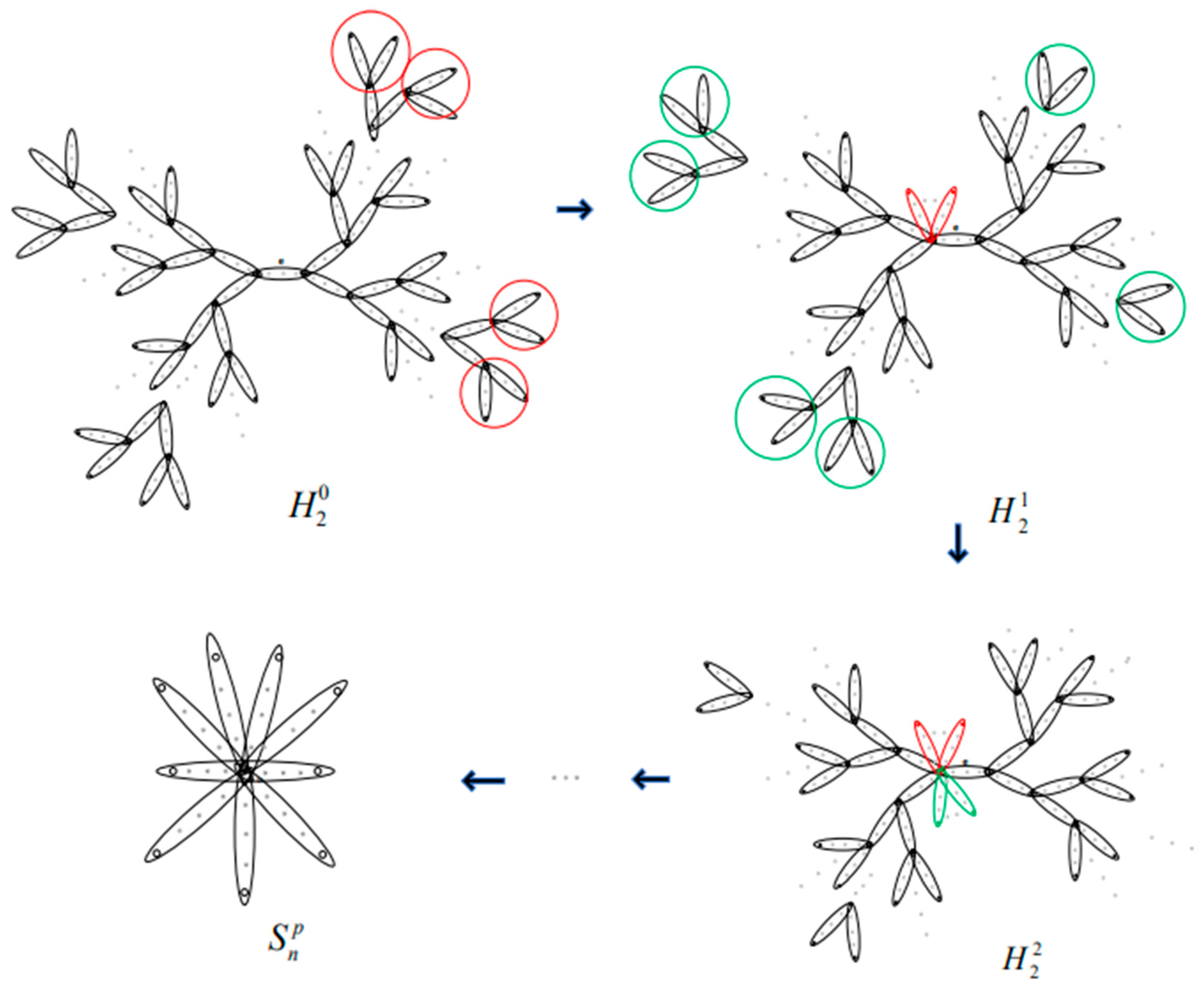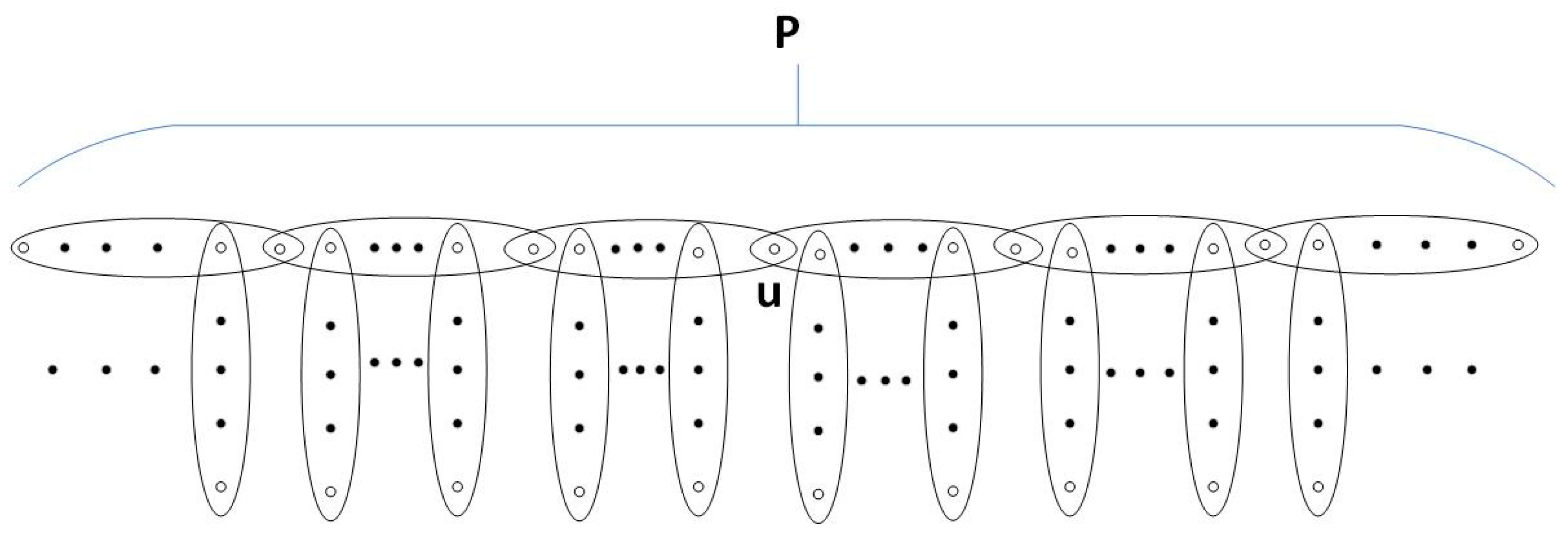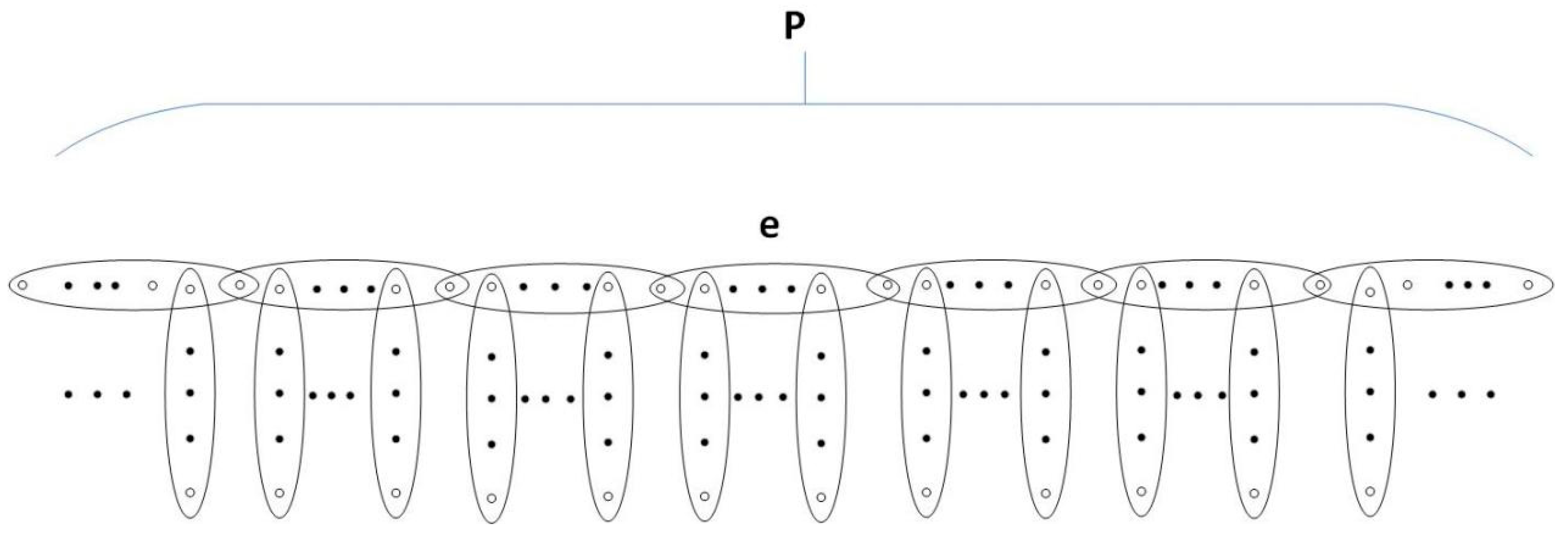1. Introduction
In 1949, Shannon proposed the concept of entropy for the first time, now named Shannon entropy [
1], which is defined as
where
is a probability distribution with
and
.
Shannon entropy is of great importance in the field of graph structure information theory. Based on Shannon entropy and some graph variables, many graph entropies were proposed; we refer to the reader to [
2,
3,
4,
5,
6,
7,
8,
9,
10,
11,
12,
13,
14,
15]. For graph entropy, there are lots of applications in chemistry, network, biology and so on; we refer to the reader to [
16,
17,
18,
19,
20,
21,
22,
23].
As a generalization of ordinary graphs, hypergraphs can express complex and high order relations such that it is often used to model complex systems. A hypergraph
with
vertices and
edges consist of a set of vertices,
, and a set of edges,
, where
,
,
. If
for
, then hypergraph
is called
-uniform. For a
-uniform hypergraph
, the degree
of a vertex
is defined as
, see [
11]. If a vertex
with
, then vertex
is called a pendent vertex. Otherwise, it is called a non-pendent vertex. The distance,
, between two vertices,
and
, is the minimum length of a path connecting
and
The radius,
, of vertex
in
is defined by
. A hyper-path
with the length of
in hypergraph
is a vertex-hyperedge alternative sequence:
, where
. In particular, if there are exactly two vertices in each hyperedge, then the hypergraph
is an ordinary graph and the hyper-path
is a path. For more terminologies, we refer readers to reference [
24].
where
.
Definition of edge contracting. Let be a hypergraph with hyperedge and exists such that the edges in are incident with …. In , by contracting the hyperedge into a vertex such that the vertex is incident with all the edges in , we get a new hypergraph, denoted by . (See Figure 1). In particular, if is a -uniform hypergraph, then by contracting for an edge , we get a new hypergraph, , satisfying and .
If there are at least two colors in each edge of hypergraph , then is properly colored. If the same color appears in one edge no more than one time in , then is strongly colored. The strong chromatic number is the smallest number such that hypergraph has a strong coloring. If a partition of is its -coloring, then it is called a chromatic decomposition of . Define a non-decreasing chromatic decomposition by whose sequence is denoted by, where . A kind of graph entropy based on the strong coloring of hypergraphs is defined as follows.
Definition 1 ([
5])
. Let be a hypergraph with vertices and edges. Let be an arbitrary chromatic decomposition of and , then the graph entropy based on the vertex strong coloring of , called the chromatic entropy of hypergraph , is given by Assume , then .
Up until now, the research works on the chromatic entropy of a hypergraph are found in only one paper: we refer to the reader to [
8]. In it, some tight upper and lower bounds of such graph entropy, as well as the corresponding extremal hypergraphs, are obtained.
In this research, the chromatic entropy based on the vertex strong coloring of a linear -uniform supertree is investigated and the maximal and minimal values are given. Furthermore, a new kind of -uniform supertrees, called hyper-dendrimers, are proposed. And we apply the results on the extremal values of chromatic entropy for linear -uniform supertrees to the case of hyper-dendrimers.
The structure of this work is as follows. In
Section 2, the extension of dendrimers in hypergraphs is presented. Some basic concepts and lemmas are given in
Section 3. In
Section 4, we show the main results of this work, which are about the extremal values of the chromatic entropy for supertrees. In
Section 5, the results in
Section 4 are applied to explore the behavior of hyper-dendrimers. A short conclusion of this paper is given in
Section 6.
It is worth nothing that there are some basic information about graphs and mathematical notations that need to be explained. In the whole paper, all the hypergraphs are undirected and unweighted. Specially, stands for the ceiling of (), and stands for the int of ().
2. The Extension of Dendrimers in Hypergraphs
Indeed, dendrimers are nanoscale radially symmetric molecules with definite, uniform, and monodisperse structures, with typical symmetrical nuclei, inner shells, and outer shells. Due to the richness and diversity of dendrimers, they have good biological properties such that there are many applications in biomedical and pharmaceutical fields, as well as in chemistry [
17,
18,
25,
26].
In 1995, Elena and Skorobogatov [
27] proposed a hypergraph model of non-classical molecular structures with multicentric delocalization bonds and presented a comparative analysis method of organometallic molecular structure model and hypergraph model indices. Using the characteristics of a hypergraph to represent the molecular structure of non-classical compounds opens a new research field, which not only generalizes the results of chemical application of graph theory, but also expands the application range of hypergraph theory [
28,
29].
Inspired by the above, we are interested in the structure of dendrimer in hypergraphs. Therefore, based on the concept of the dendrimer, the definition of hyper-dendrimer is given below.
Definition 2. Let be a linear -uniform supertree with vertices, and the size of is , where , and . If the following conditions can be satisfied, then is called a homogeneous hyper-dendrimer.
- (i)
The degrees of all non-pendant vertices of are the same; and the degree of all non-pendant vertices of is at least 2.
- (ii)
There is a central vertex in satisfying that is symmetric with respect to vertex . Otherwise, there is one central edge in such that it can be changed into a -uniform supertree possessing a central vertex by contracting the edge .
The set of these kinds of hyper-dendrimers is denoted by . Obviously, .
Two hyper-dendrimers with a central vertex,
, and a central edge, e, are given in
Figure 2 and
Figure 3, respectively. Obviously, as
,
is a dendrimer. Two dendrimers with a central vertex
and a central edge
are shown in
Figure 4 and
Figure 5, respectively.
3. Preliminaries
In this section, some basic concepts and lemmas are given.
Definition 3 ([
30])
. A supertree is a hypergraph which is both connected and acyclic. Definition 4 ([
31])
. Let be a 2-uniform graph. For any, the -th power of , denoted by , is defined as the -uniform hypergraph with the set of vertices and the set of edges , where are new added vertices for .
Definition 5 ([
31])
. The -th power of , denoted by , is called a hyper-star.
Definition 6 ([
24])
. A hypergraph is linear if it is simple and for all where .
In the whole paper, the linear -uniform supertree with vertices is denoted by . By the Definition 3 and Definition 6 above, it is easy to see that the size of is . Moreover, the set of all this kind of supertrees is denoted by .
Definition 7 ([
30])
. (Moving edges operation)
Let and be a hypergraph with and such that for Suppose that and write , Let be the hypergraph with . Then we say that is obtained from by moving edges from to.
Lemma 1 ([
5])
. Let be a -uniform hypergraph on vertices with edges and connected component. If , then .
Lemma 2 ([
5])
. Suppose , where , and . For any ,, if or , then obtains the minimal value. 4. The Chromatic Entropy of Linear Supertrees
Now we show an operation of moving edges for a linear
-uniform supertree
such that its chromatic entropy decreases. Denote the non-decreasing chromatic decomposition sequence of
by
. Suppose
is the vertex with the maximum degree among
. There exists
and
but
. Using the operation of moving edges in
in Definition 7, we obtain a new supertree
with
, where
Then we obtain a new non-decreasing chromatic sequence with a strong color of . Thus, we have
Lemma 3. For any , follows.
Proof. If , then and are bipartite graphs. Then 2. As , by Lemma 1, .
Let. Now we discuss the following two cases based on the colors of vertices and.
Case 1. The colors of vertices and are the same in . Then it does not change the chromatic decomposition sequence of under the operation of moving edges, i.e., . Therefore, we have .
Case 2. The color of the vertex is different from that for vertex in . Since vertex is with the maximum degree in , without loss of generality, it is colored with color and the vertex is colored with color . Since supertree is p-uniform, the other vertices of are colored with colors, respectively. By the operation of moving edges, a new edge can be obtained, which consists of the vertices of and vertex . Therefore, we get a supertree with , where . Since is strong coloring, there is a vertex with color in . Now we color with color in . For the rest of vertices, their colors remain unchanged. Then we get a strong coloring of . It is easy to find that the number of vertices with color decreases by 1, and that with color increases by 1. It arrives at .
Therefore,
where
,
.
Then . By Definition 1, we have . □
By using Lemma 3 repeatedly, for any linear -uniform supertree , we obtain.
Theorem 1. For any , follows, where and equality holds as .
Proof. By Lemma 1,
p. For hyper-star
, without loss of generality, we color the vertex possessing the maximum degree with color
, and color the other vertices in different edges with colors
, respectively. Then we get a strong coloring of
with
Then . Using Lemma 3 repeatedly, we have . □
Theorem 2. For any , it holdswhere and equality holds as , where is the linear -uniform supertree obtained by attaching pendant edges as many as possible to a hyper-path satisfying that its maximum degree is 2. Proof. By Lemma 1,
. Let
be the number of all non-pendant edges of
. By the structure of
, there is only one hyper-path,
, which is composed of the
non-pendant edges. That is,
where
.
According to the strong coloring for a hypergraph, we color the vertices of
in the order
with
colors
in sequence. Then for each pendant edge, we color
vertices of degree 1 with
colors, respectively, which are different from that of the non-pendant vertex in the same pendant edge. Thus, we obtain a chromatic composition sequence of
for strong coloring, which is given as follows.
where
. And it arrives
Note that , where By Lemma 2, the inequality follows. □
5. Applications on Chromatic Entropy for Hyper-Dendrimers
Considering the discussions above, the structure of hyper-star can also be considered as a hyper-dendrimer. From Theorem 1, the following corollary can be obtained directly.
Corollary 1. For any , holds, where and equality holds as .
In fact, for any hyper-dendrimer , it can be obtained from the expending of a core molecule, which is a supertree with small orders. Inversely, we focus on the polymerization of a hyper-dendrimer, which can intuitively be presented in the dynamic process of reducing the chromatic entropy value by repeatedly using Lemma 3, where the polymerization means that the hyper-dendrimer with a complex structure scale was reduced by the operation of moving edges, but the number of vertices and edges remained unchanged. Two cases of polymerization for a hyper-dendrimer are shown as follows.
Case 1. Let
, whose central vertex is
. The hyper-dendrimer
can be seen in
Figure 6. Let the radius of vertex
be
. In
, if the edge
containing
vertices whose distances from the central vertex
are all
, by the operation of moving edges, the edge
is moved to vertex
, i.e., the edge appeared in the red cycle. After similar operations for such kind of edges, we get hypergraph
. By Lemma 3,
. In
, if an edge containing
vertices whose distances from the central vertex
are all
, by the operation of moving edges, the edge is moved to vertex
, i.e., the edge appeared in the green cycle. After similar operations for such kind of edges, we get hypergraph
. By Lemma 3,
. We repeat these operations until
. Then it arrives at
The corresponding process can be seen in
Figure 7.
Case 2. Let
, in which there is a central edge,
. The hyper-dendrimer
can be found in
Figure 3. Let
be a non-pendant vertex, whose radius is
. Through similar operations as Case 1, with the decreasing of the radius of
, a series of graphs
,
,
,
can be obtained. Thus, by Lemma 3, we have
The corresponding process can be seen in
Figure 8.
Therefore, the hyper-star attains the minimal value among .
Though hyper-dendrimers are a class of special linear supertrees, they behave differently in the extremal graphs on their chromatic entropy due to the symmetry of a hyper-dendrimer.
Theorem 3. For any , it followswhere and equality holds as , where is the hyper-dendrimer obtained from attaching pendant edges as many as possible to a hyper-path, P, such that its maximum degree is 2. In particular, if the size of is even, then is a hyper-dendrimer with a central vertex (see Figure 9). Otherwise, is a hyper-dendrimer with a central edge, (see Figure 10). Proof. With a similar coloring as in the proof of Theorem 2, by the structure of and Lemma 3, the result holds. □
Next, we give an example to show that there are different supertrees sharing the same maximal chromatic entropy.
Example 1. The hyper-dendrimer and the linear 4-uniform supertree are drawn in Figure 11 and Figure 12, respectively. We can check that However, the hyper-dendrimer is symmetrical respect to the central vertex , which is different from .
6. Conclusions
This work studies the extremal values as well as the corresponding extremal graphs of the chromatic entropy for linear -uniform supertrees. Besides, new kinds of supertrees based on dendrimers are constructed, called hyper-dendrimer. Moreover, the dynamic process of chromatic entropy for hyper-dendrimers are shown by using the operation of moving edges. In the future, we will continue to consider the extremal values of chromatic entropy for some other special classes of hypergraphs, such as the unicyclic hypergraphs and bicyclic hypergraphs.

